Page 302 of 345
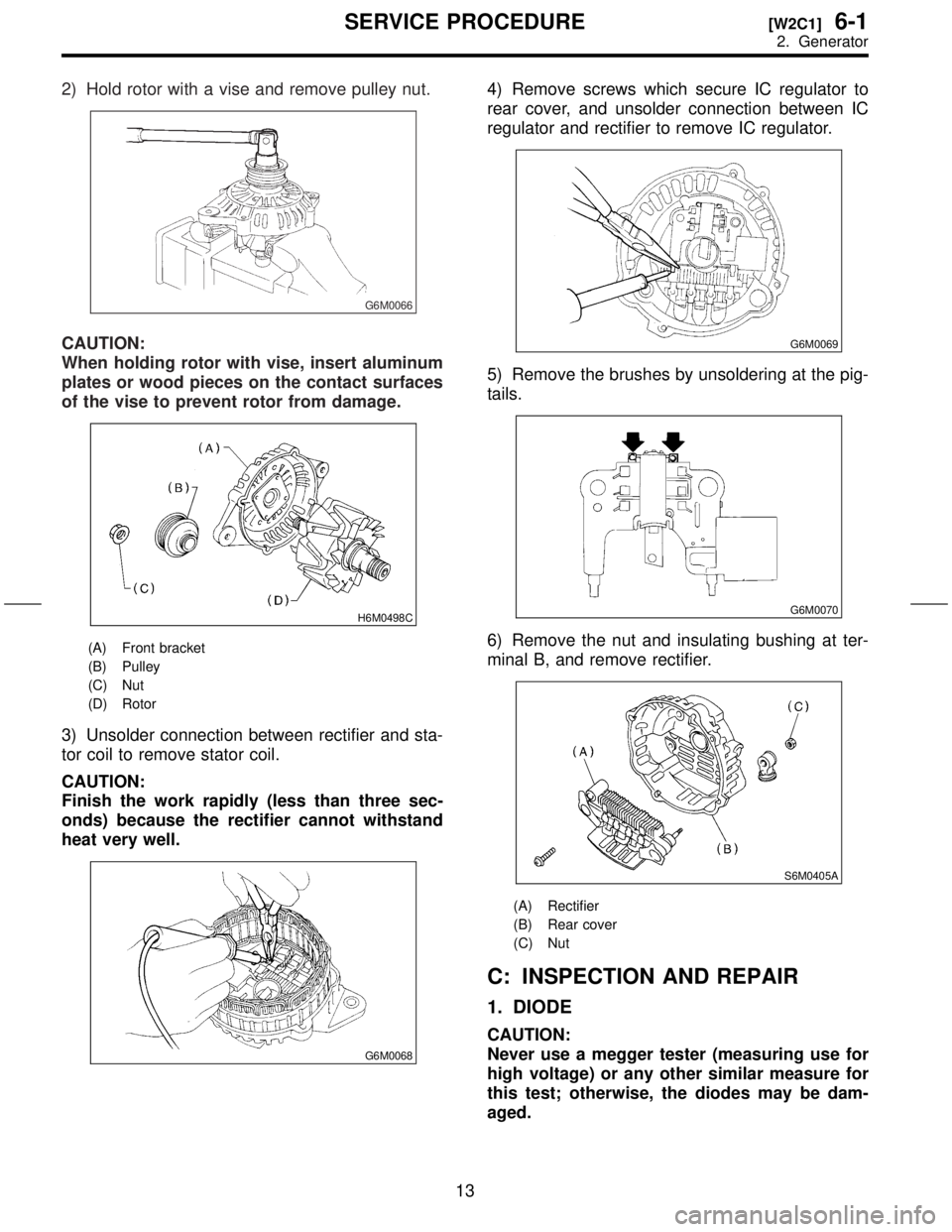
2) Hold rotor with a vise and remove pulley nut.
G6M0066
CAUTION:
When holding rotor with vise, insert aluminum
plates or wood pieces on the contact surfaces
of the vise to prevent rotor from damage.
H6M0498C
(A) Front bracket
(B) Pulley
(C) Nut
(D) Rotor
3) Unsolder connection between rectifier and sta-
tor coil to remove stator coil.
CAUTION:
Finish the work rapidly (less than three sec-
onds) because the rectifier cannot withstand
heat very well.
G6M0068
4) Remove screws which secure IC regulator to
rear cover, and unsolder connection between IC
regulator and rectifier to remove IC regulator.
G6M0069
5) Remove the brushes by unsoldering at the pig-
tails.
G6M0070
6) Remove the nut and insulating bushing at ter-
minal B, and remove rectifier.
S6M0405A
(A) Rectifier
(B) Rear cover
(C) Nut
C: INSPECTION AND REPAIR
1. DIODE
CAUTION:
Never use a megger tester (measuring use for
high voltage) or any other similar measure for
this test; otherwise, the diodes may be dam-
aged.
13
[W2C1]6-1SERVICE PROCEDURE
2. Generator
Page 303 of 345
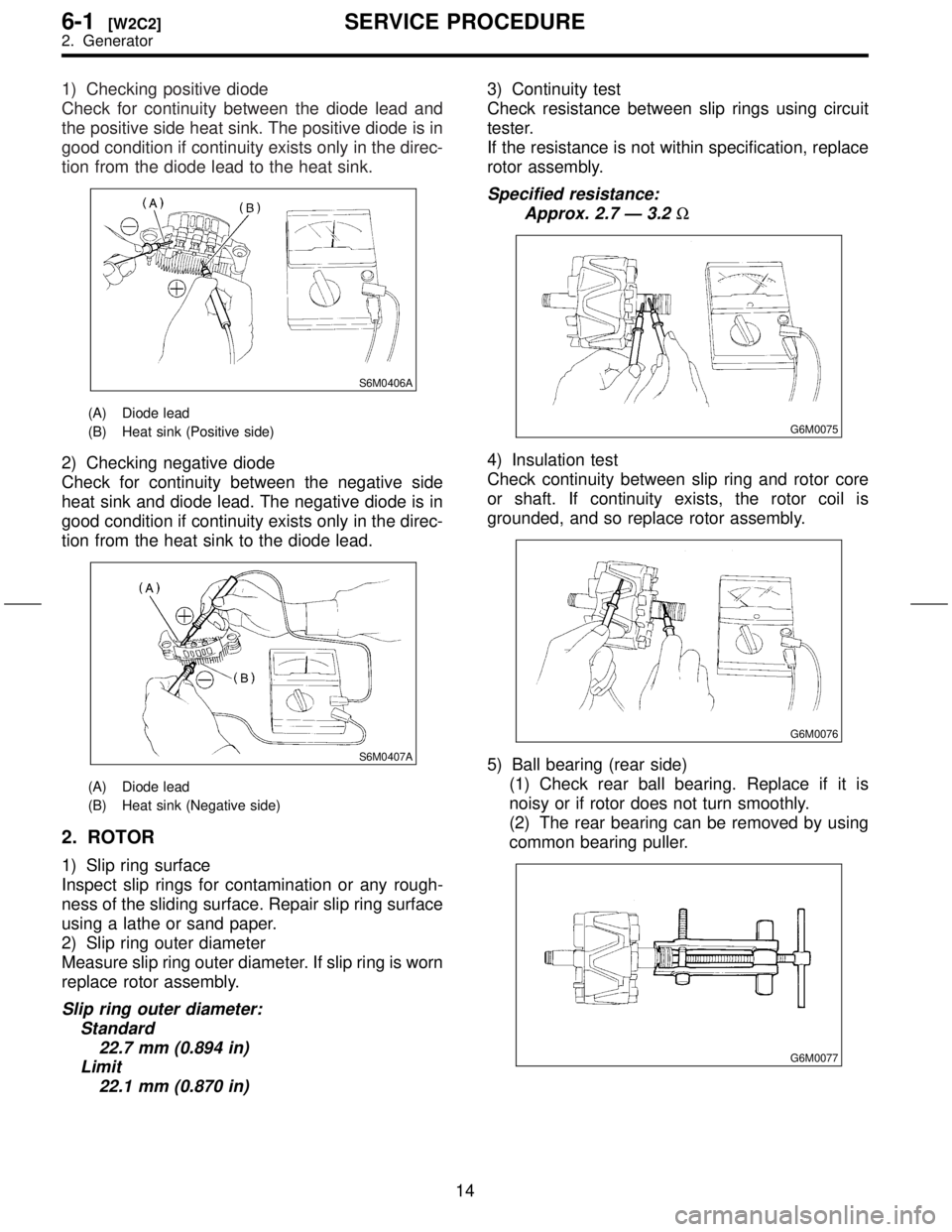
1) Checking positive diode
Check for continuity between the diode lead and
the positive side heat sink. The positive diode is in
good condition if continuity exists only in the direc-
tion from the diode lead to the heat sink.
S6M0406A
(A) Diode lead
(B) Heat sink (Positive side)
2) Checking negative diode
Check for continuity between the negative side
heat sink and diode lead. The negative diode is in
good condition if continuity exists only in the direc-
tion from the heat sink to the diode lead.
S6M0407A
(A) Diode lead
(B) Heat sink (Negative side)
2. ROTOR
1) Slip ring surface
Inspect slip rings for contamination or any rough-
ness of the sliding surface. Repair slip ring surface
using a lathe or sand paper.
2) Slip ring outer diameter
Measure slip ring outer diameter. If slip ring is worn
replace rotor assembly.
Slip ring outer diameter:
Standard
22.7 mm (0.894 in)
Limit
22.1 mm (0.870 in)
3) Continuity test
Check resistance between slip rings using circuit
tester.
If the resistance is not within specification, replace
rotor assembly.
Specified resistance:
Approx. 2.7 Ð 3.2
W
G6M0075
4) Insulation test
Check continuity between slip ring and rotor core
or shaft. If continuity exists, the rotor coil is
grounded, and so replace rotor assembly.
G6M0076
5) Ball bearing (rear side)
(1) Check rear ball bearing. Replace if it is
noisy or if rotor does not turn smoothly.
(2) The rear bearing can be removed by using
common bearing puller.
G6M0077
14
6-1[W2C2]SERVICE PROCEDURE
2. Generator
Page 304 of 345
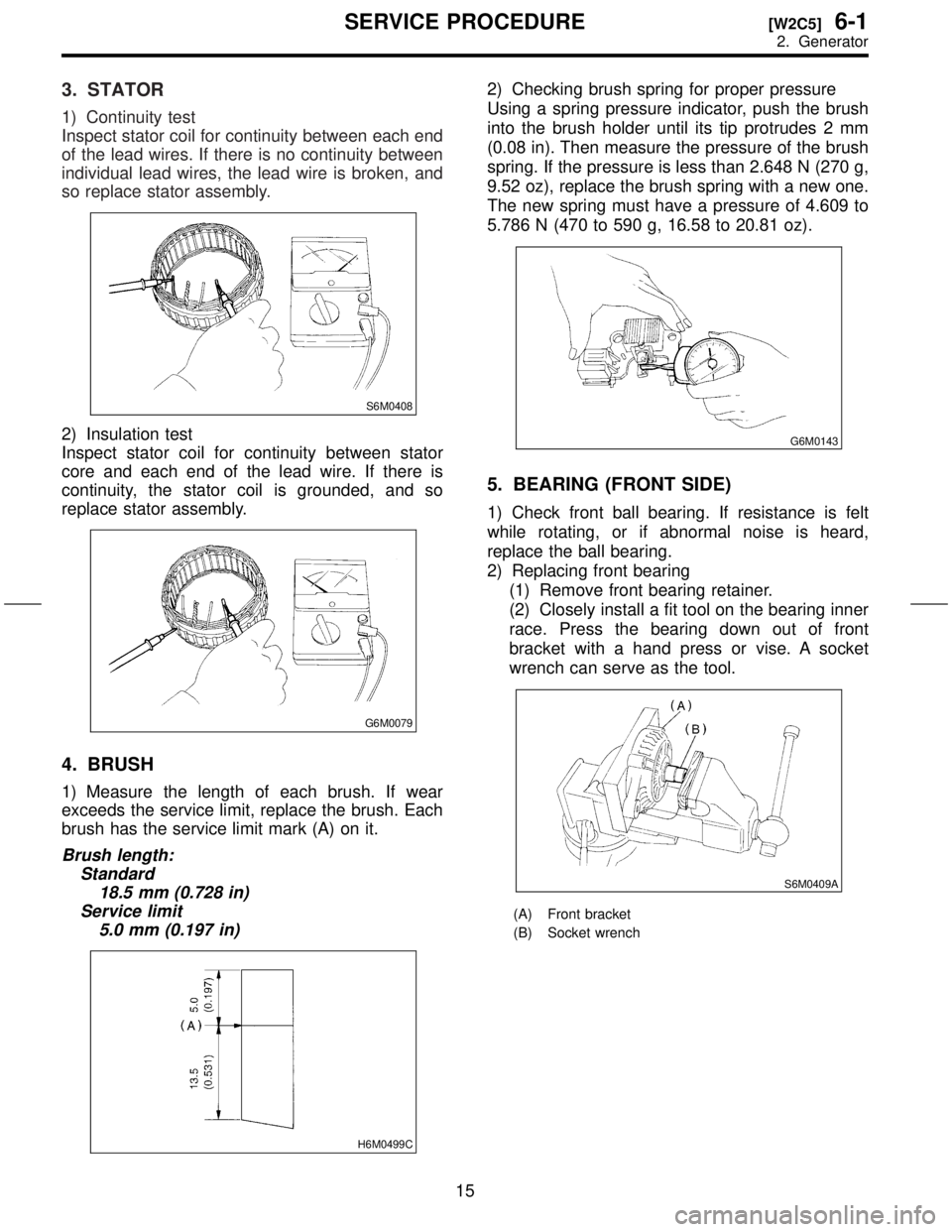
3. STATOR
1) Continuity test
Inspect stator coil for continuity between each end
of the lead wires. If there is no continuity between
individual lead wires, the lead wire is broken, and
so replace stator assembly.
S6M0408
2) Insulation test
Inspect stator coil for continuity between stator
core and each end of the lead wire. If there is
continuity, the stator coil is grounded, and so
replace stator assembly.
G6M0079
4. BRUSH
1) Measure the length of each brush. If wear
exceeds the service limit, replace the brush. Each
brush has the service limit mark (A) on it.
Brush length:
Standard
18.5 mm (0.728 in)
Service limit
5.0 mm (0.197 in)
H6M0499C
2) Checking brush spring for proper pressure
Using a spring pressure indicator, push the brush
into the brush holder until its tip protrudes 2 mm
(0.08 in). Then measure the pressure of the brush
spring. If the pressure is less than 2.648 N (270 g,
9.52 oz), replace the brush spring with a new one.
The new spring must have a pressure of 4.609 to
5.786 N (470 to 590 g, 16.58 to 20.81 oz).
G6M0143
5. BEARING (FRONT SIDE)
1) Check front ball bearing. If resistance is felt
while rotating, or if abnormal noise is heard,
replace the ball bearing.
2) Replacing front bearing
(1) Remove front bearing retainer.
(2) Closely install a fit tool on the bearing inner
race. Press the bearing down out of front
bracket with a hand press or vise. A socket
wrench can serve as the tool.
S6M0409A
(A) Front bracket
(B) Socket wrench
15
[W2C5]6-1SERVICE PROCEDURE
2. Generator
Page 305 of 345
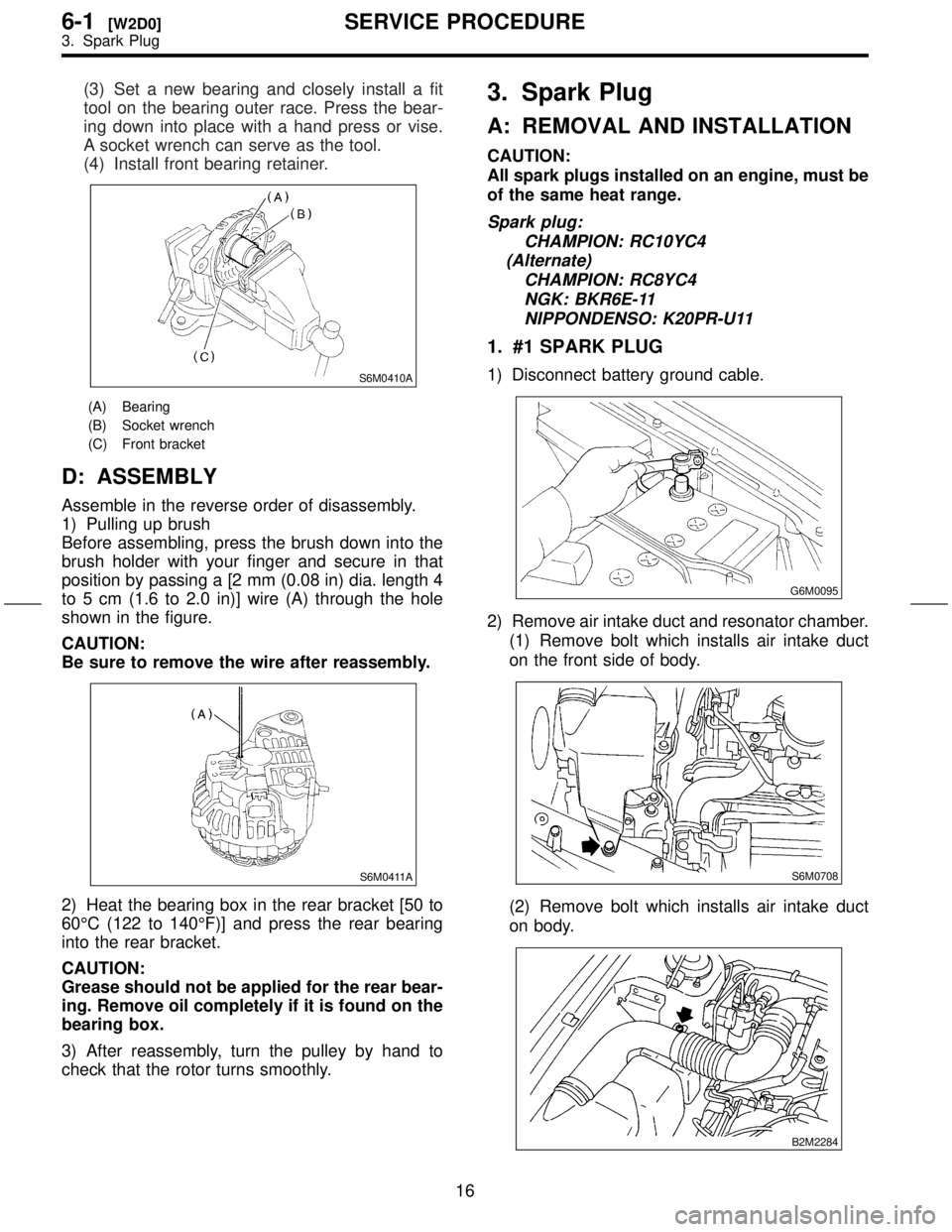
(3) Set a new bearing and closely install a fit
tool on the bearing outer race. Press the bear-
ing down into place with a hand press or vise.
A socket wrench can serve as the tool.
(4) Install front bearing retainer.
S6M0410A
(A) Bearing
(B) Socket wrench
(C) Front bracket
D: ASSEMBLY
Assemble in the reverse order of disassembly.
1) Pulling up brush
Before assembling, press the brush down into the
brush holder with your finger and secure in that
position by passing a [2 mm (0.08 in) dia. length 4
to 5 cm (1.6 to 2.0 in)] wire (A) through the hole
shown in the figure.
CAUTION:
Be sure to remove the wire after reassembly.
S6M0411A
2) Heat the bearing box in the rear bracket [50 to
60ÉC (122 to 140ÉF)] and press the rear bearing
into the rear bracket.
CAUTION:
Grease should not be applied for the rear bear-
ing. Remove oil completely if it is found on the
bearing box.
3) After reassembly, turn the pulley by hand to
check that the rotor turns smoothly.
3. Spark Plug
A: REMOVAL AND INSTALLATION
CAUTION:
All spark plugs installed on an engine, must be
of the same heat range.
Spark plug:
CHAMPION: RC10YC4
(Alternate)
CHAMPION: RC8YC4
NGK: BKR6E-11
NIPPONDENSO: K20PR-U11
1. #1 SPARK PLUG
1) Disconnect battery ground cable.
G6M0095
2) Remove air intake duct and resonator chamber.
(1) Remove bolt which installs air intake duct
on the front side of body.
S6M0708
(2) Remove bolt which installs air intake duct
on body.
B2M2284
16
6-1[W2D0]SERVICE PROCEDURE
3. Spark Plug
Page 306 of 345
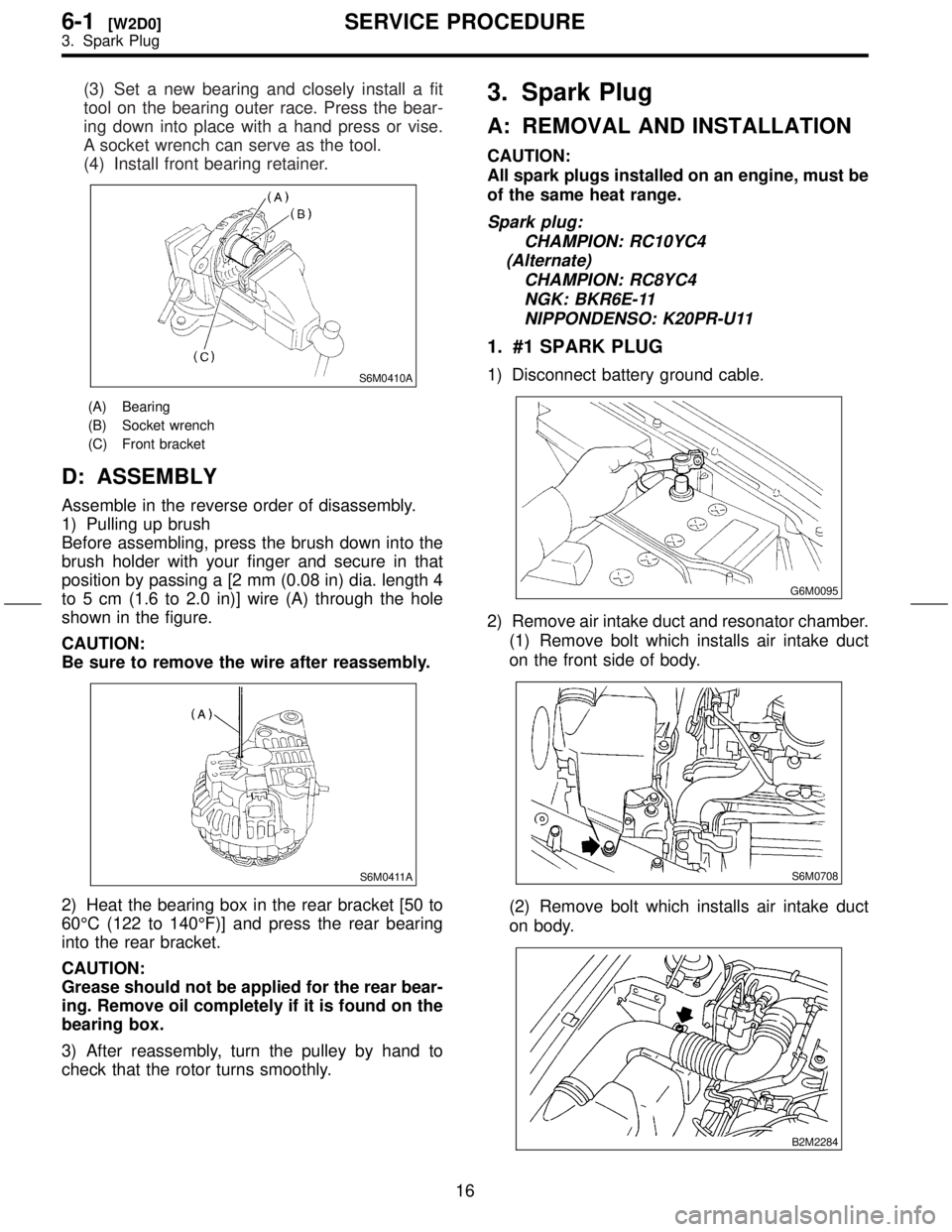
(3) Set a new bearing and closely install a fit
tool on the bearing outer race. Press the bear-
ing down into place with a hand press or vise.
A socket wrench can serve as the tool.
(4) Install front bearing retainer.
S6M0410A
(A) Bearing
(B) Socket wrench
(C) Front bracket
D: ASSEMBLY
Assemble in the reverse order of disassembly.
1) Pulling up brush
Before assembling, press the brush down into the
brush holder with your finger and secure in that
position by passing a [2 mm (0.08 in) dia. length 4
to 5 cm (1.6 to 2.0 in)] wire (A) through the hole
shown in the figure.
CAUTION:
Be sure to remove the wire after reassembly.
S6M0411A
2) Heat the bearing box in the rear bracket [50 to
60ÉC (122 to 140ÉF)] and press the rear bearing
into the rear bracket.
CAUTION:
Grease should not be applied for the rear bear-
ing. Remove oil completely if it is found on the
bearing box.
3) After reassembly, turn the pulley by hand to
check that the rotor turns smoothly.
3. Spark Plug
A: REMOVAL AND INSTALLATION
CAUTION:
All spark plugs installed on an engine, must be
of the same heat range.
Spark plug:
CHAMPION: RC10YC4
(Alternate)
CHAMPION: RC8YC4
NGK: BKR6E-11
NIPPONDENSO: K20PR-U11
1. #1 SPARK PLUG
1) Disconnect battery ground cable.
G6M0095
2) Remove air intake duct and resonator chamber.
(1) Remove bolt which installs air intake duct
on the front side of body.
S6M0708
(2) Remove bolt which installs air intake duct
on body.
B2M2284
16
6-1[W2D0]SERVICE PROCEDURE
3. Spark Plug
Page 307 of 345
(3) Remove air intake duct as a unit.
B2M2012
(4) Remove resonator chamber.
B2M2306
3) Remove #1 spark plug cord by pulling boot, not
the cord itself.
B6M0922
4) Remove spark plug with the spark plug socket.
B6M0923
5) Install in the reverse order of removal.
Tightening torque (Spark plug):
20.6
±2.9 N´m (2.10±0.30 kg-m, 15.19±2.14
ft-lb)
Tightening torque (Resonator chamber):
32
±10 N´m (3.3±1.0 kg-m, 24±7 ft-lb)
B2M2306
CAUTION:
The above torque should be only applied to
new spark plugs without oil on their threads.
In case their threads are lubricated, the torque
should be reduced by approximately 1/3 of the
specified torque in order to avoid over-stress-
ing.
2. #2 SPARK PLUG
1) Disconnect battery ground cable.
G6M0095
2) Remove #2 spark plug cord by pulling boot, not
cord itself.
B6M0927
17
[W3A2]6-1SERVICE PROCEDURE
3. Spark Plug
Page 308 of 345
3) Remove spark plug with the spark plug socket.
B6M0924
4) Install in the reverse order of removal.
Tightening torque (Spark plug):
20.6
±2.9 N´m (2.10±0.30 kg-m, 15.19±2.14
ft-lb)
CAUTION:
The above torque should be only applied to
new spark plugs without oil on their threads.
In case their threads are lubricated, the torque
should be reduced by approximately 1/3 of the
specified torque in order to avoid over-stress-
ing.
3. #3 SPARK PLUG
1) Disconnect battery ground cable.
G6M0095
2) Remove air intake duct and resonator chamber.
(1) Remove bolt which installs air intake duct
on the front side of body.
S6M0708
(2) Remove bolt which installs air intake duct
on body.
B2M2284
(3) Remove air intake duct as a unit.
B2M2012
(4) Remove resonator chamber.
B2M2306
3) Remove #3 spark plug cord by pulling boot, not
cord itself.
B6M0928
18
6-1[W3A3]SERVICE PROCEDURE
3. Spark Plug
Page 309 of 345
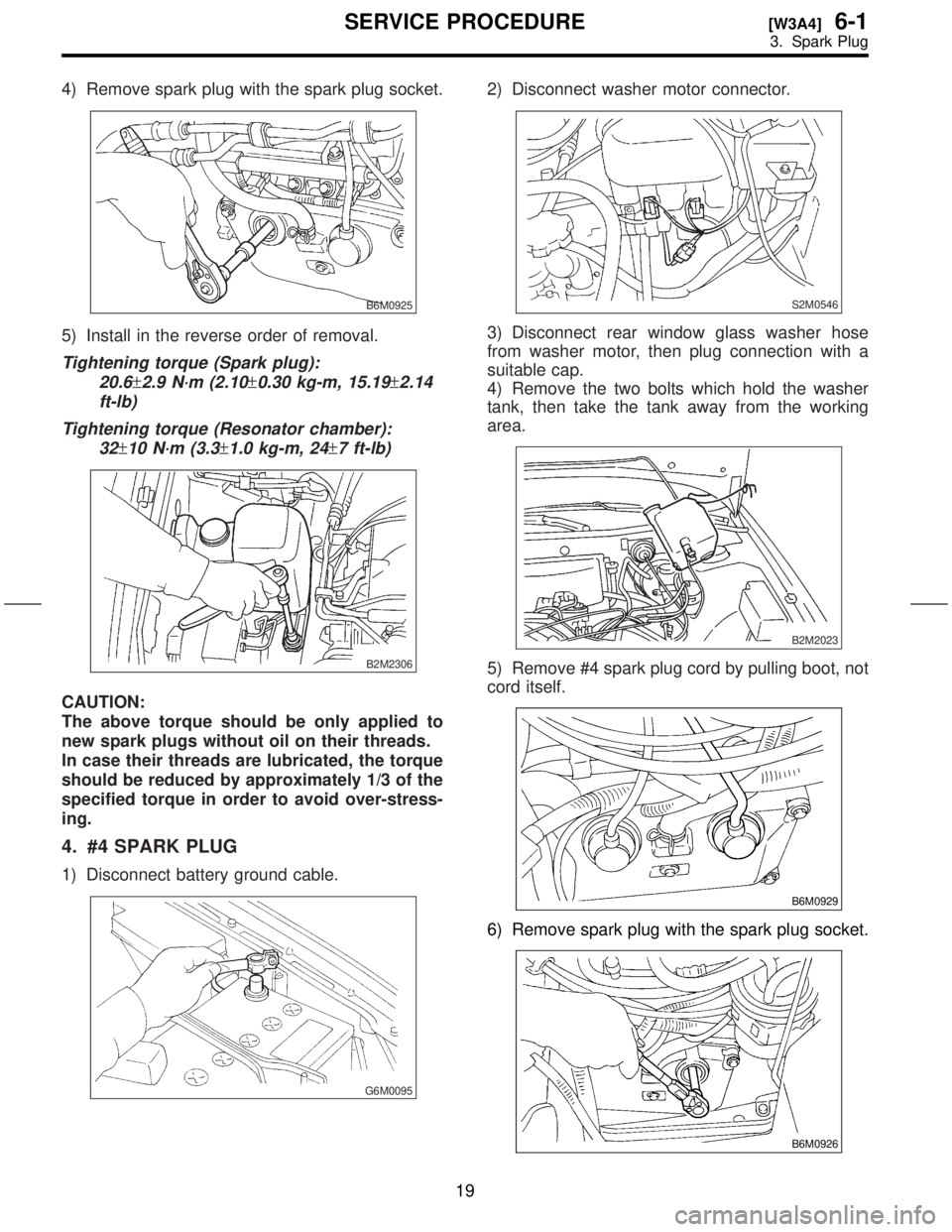
4) Remove spark plug with the spark plug socket.
B6M0925
5) Install in the reverse order of removal.
Tightening torque (Spark plug):
20.6
±2.9 N´m (2.10±0.30 kg-m, 15.19±2.14
ft-lb)
Tightening torque (Resonator chamber):
32
±10 N´m (3.3±1.0 kg-m, 24±7 ft-lb)
B2M2306
CAUTION:
The above torque should be only applied to
new spark plugs without oil on their threads.
In case their threads are lubricated, the torque
should be reduced by approximately 1/3 of the
specified torque in order to avoid over-stress-
ing.
4. #4 SPARK PLUG
1) Disconnect battery ground cable.
G6M0095
2) Disconnect washer motor connector.
S2M0546
3) Disconnect rear window glass washer hose
from washer motor, then plug connection with a
suitable cap.
4) Remove the two bolts which hold the washer
tank, then take the tank away from the working
area.
B2M2023
5) Remove #4 spark plug cord by pulling boot, not
cord itself.
B6M0929
6) Remove spark plug with the spark plug socket.
B6M0926
19
[W3A4]6-1SERVICE PROCEDURE
3. Spark Plug